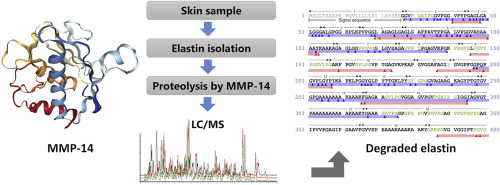Our official English website, www.x-mol.net, welcomes your
feedback! (Note: you will need to create a separate account there.)
MMP-14 degrades tropoelastin and elastin.
Biochimie ( IF 3.3 ) Pub Date : 2019-07-03 , DOI: 10.1016/j.biochi.2019.07.001 Natalia Miekus 1 , Chiara Luise 2 , Wolfgang Sippl 2 , Tomasz Baczek 3 , Christian E H Schmelzer 4 , Andrea Heinz 5
Biochimie ( IF 3.3 ) Pub Date : 2019-07-03 , DOI: 10.1016/j.biochi.2019.07.001 Natalia Miekus 1 , Chiara Luise 2 , Wolfgang Sippl 2 , Tomasz Baczek 3 , Christian E H Schmelzer 4 , Andrea Heinz 5
Affiliation

|
Matrix metalloproteinases are a class of enzymes, which degrade extracellular matrix components such as collagens, elastin, laminin or fibronectin. So far, four matrix metalloproteinases have been shown to degrade elastin and its precursor tropoelastin, namely matrix metalloproteinase-2, -7, -9 and -12. This study focuses on investigating the elastinolytic capability of membrane-type 1 matrix metalloproteinase, also known as matrix metalloproteinase-14. We digested recombinant human tropoelastin and human skin elastin with matrix metalloproteinase-14 and analyzed the peptide mixtures using complementary mass spectrometric techniques and bioinformatics tools. The results and additional molecular docking studies show that matrix metalloproteinase-14 cleaves tropoelastin as well as elastin. While tropoelastin was well degraded, fewer cleavages occurred in the highly cross-linked mature elastin. The study also provides insights into the cleavage preferences of the enzyme. Similar to cleavage preferences of matrix metalloproteinases-2, -7, -9 and -12, matrix metalloproteinase-14 prefers small and medium-sized hydrophobic residues including Gly, Ala, Leu and Val at cleavage site P1'. Pro, Gly and Ala were preferably found at P1-P4 and P2'-P4' in both tropoelastin and elastin. Cleavage of mature skin elastin by matrix metalloproteinase-14 released a variety of bioactive elastin peptides, which indicates that the enzyme may play a role in the development and progression of cardiovascular diseases that go along with elastin breakdown.
中文翻译:

MMP-14降解原弹性蛋白和弹性蛋白。
基质金属蛋白酶是一类酶,其降解细胞外基质成分,例如胶原蛋白,弹性蛋白,层粘连蛋白或纤连蛋白。到目前为止,已显示四种基质金属蛋白酶可降解弹性蛋白及其前体原弹性蛋白,即基质金属蛋白酶-2,-7,-9和-12。这项研究的重点是研究膜型1基质金属蛋白酶(也称为基质金属蛋白酶14)的弹性蛋白酶降解能力。我们用基质金属蛋白酶14消化了重组人原弹性蛋白和人皮肤弹性蛋白,并使用互补质谱技术和生物信息学工具分析了肽混合物。结果和其他分子对接研究表明,基质金属蛋白酶14裂解弹性蛋白和弹性蛋白。尽管原弹性蛋白降解良好,在高度交联的成熟弹性蛋白中发生的裂解较少。该研究还提供了对酶切割偏好的见解。与基质金属蛋白酶-2,-7,-9和-12的切割偏好相似,基质金属蛋白酶-14更喜欢在切割位点P1'处的中小疏水残基,包括Gly,Ala,Leu和Val。在原弹性蛋白和弹性蛋白中都优选在P1-P4和P2'-P4'处发现了Pro,Gly和Ala。基质金属蛋白酶14裂解成熟的皮肤弹性蛋白释放出多种生物活性弹性蛋白肽,这表明该酶可能在与弹性蛋白分解有关的心血管疾病的发生和发展中发挥作用。与基质金属蛋白酶-2,-7,-9和-12的切割偏好相似,基质金属蛋白酶-14更喜欢在切割位点P1'处的中小疏水残基,包括Gly,Ala,Leu和Val。在原弹性蛋白和弹性蛋白中都优选在P1-P4和P2'-P4'处发现了Pro,Gly和Ala。基质金属蛋白酶14裂解成熟的皮肤弹性蛋白释放出多种生物活性弹性蛋白肽,这表明该酶可能在与弹性蛋白分解有关的心血管疾病的发生和发展中发挥作用。与基质金属蛋白酶-2,-7,-9和-12的切割偏好相似,基质金属蛋白酶-14更喜欢在切割位点P1'处的中小疏水残基,包括Gly,Ala,Leu和Val。在原弹性蛋白和弹性蛋白中都优选在P1-P4和P2'-P4'处发现了Pro,Gly和Ala。基质金属蛋白酶14裂解成熟的皮肤弹性蛋白释放出多种生物活性弹性蛋白肽,这表明该酶可能在与弹性蛋白分解有关的心血管疾病的发生和发展中发挥作用。在原弹性蛋白和弹性蛋白中。基质金属蛋白酶14裂解成熟的皮肤弹性蛋白释放出多种生物活性弹性蛋白肽,这表明该酶可能在与弹性蛋白分解有关的心血管疾病的发生和发展中发挥作用。在原弹性蛋白和弹性蛋白中。基质金属蛋白酶14裂解成熟的皮肤弹性蛋白释放出多种生物活性弹性蛋白肽,这表明该酶可能在与弹性蛋白分解有关的心血管疾病的发生和发展中发挥作用。
更新日期:2019-07-03
中文翻译:

MMP-14降解原弹性蛋白和弹性蛋白。
基质金属蛋白酶是一类酶,其降解细胞外基质成分,例如胶原蛋白,弹性蛋白,层粘连蛋白或纤连蛋白。到目前为止,已显示四种基质金属蛋白酶可降解弹性蛋白及其前体原弹性蛋白,即基质金属蛋白酶-2,-7,-9和-12。这项研究的重点是研究膜型1基质金属蛋白酶(也称为基质金属蛋白酶14)的弹性蛋白酶降解能力。我们用基质金属蛋白酶14消化了重组人原弹性蛋白和人皮肤弹性蛋白,并使用互补质谱技术和生物信息学工具分析了肽混合物。结果和其他分子对接研究表明,基质金属蛋白酶14裂解弹性蛋白和弹性蛋白。尽管原弹性蛋白降解良好,在高度交联的成熟弹性蛋白中发生的裂解较少。该研究还提供了对酶切割偏好的见解。与基质金属蛋白酶-2,-7,-9和-12的切割偏好相似,基质金属蛋白酶-14更喜欢在切割位点P1'处的中小疏水残基,包括Gly,Ala,Leu和Val。在原弹性蛋白和弹性蛋白中都优选在P1-P4和P2'-P4'处发现了Pro,Gly和Ala。基质金属蛋白酶14裂解成熟的皮肤弹性蛋白释放出多种生物活性弹性蛋白肽,这表明该酶可能在与弹性蛋白分解有关的心血管疾病的发生和发展中发挥作用。与基质金属蛋白酶-2,-7,-9和-12的切割偏好相似,基质金属蛋白酶-14更喜欢在切割位点P1'处的中小疏水残基,包括Gly,Ala,Leu和Val。在原弹性蛋白和弹性蛋白中都优选在P1-P4和P2'-P4'处发现了Pro,Gly和Ala。基质金属蛋白酶14裂解成熟的皮肤弹性蛋白释放出多种生物活性弹性蛋白肽,这表明该酶可能在与弹性蛋白分解有关的心血管疾病的发生和发展中发挥作用。与基质金属蛋白酶-2,-7,-9和-12的切割偏好相似,基质金属蛋白酶-14更喜欢在切割位点P1'处的中小疏水残基,包括Gly,Ala,Leu和Val。在原弹性蛋白和弹性蛋白中都优选在P1-P4和P2'-P4'处发现了Pro,Gly和Ala。基质金属蛋白酶14裂解成熟的皮肤弹性蛋白释放出多种生物活性弹性蛋白肽,这表明该酶可能在与弹性蛋白分解有关的心血管疾病的发生和发展中发挥作用。在原弹性蛋白和弹性蛋白中。基质金属蛋白酶14裂解成熟的皮肤弹性蛋白释放出多种生物活性弹性蛋白肽,这表明该酶可能在与弹性蛋白分解有关的心血管疾病的发生和发展中发挥作用。在原弹性蛋白和弹性蛋白中。基质金属蛋白酶14裂解成熟的皮肤弹性蛋白释放出多种生物活性弹性蛋白肽,这表明该酶可能在与弹性蛋白分解有关的心血管疾病的发生和发展中发挥作用。











































 京公网安备 11010802027423号
京公网安备 11010802027423号